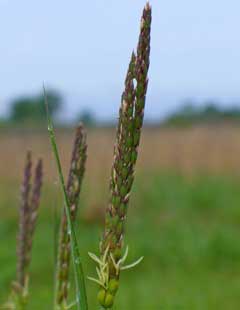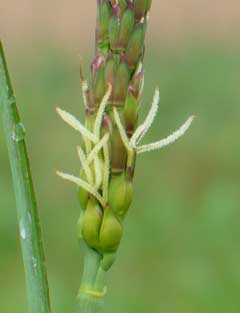 |
|
USDA-NRCS PLANTS Database |
 |
| USDA-NRCS PLANTS Database |
Translate this page:
Summary
Bloom Color: Yellow. Main Bloom Time: Early fall, Mid fall. Form: Rounded.
Physical Characteristics

 Tripsacum dactyloides is a PERENNIAL growing to 2.5 m (8ft) by 1 m (3ft 3in) at a medium rate.
Tripsacum dactyloides is a PERENNIAL growing to 2.5 m (8ft) by 1 m (3ft 3in) at a medium rate.
See above for USDA hardiness. It is hardy to UK zone 7 and is not frost tender. It is in flower from August to September. The species is monoecious (individual flowers are either male or female, but both sexes can be found on the same plant) and is pollinated by Wind.
Suitable for: light (sandy), medium (loamy) and heavy (clay) soils. Suitable pH: mildly acid, neutral and basic (mildly alkaline) soils. It cannot grow in the shade. It prefers moist soil.
UK Hardiness Map
US Hardiness Map
Synonyms
Plant Habitats
Woodland Garden Sunny Edge; Cultivated Beds;
Edible Uses
Edible Parts: Seed
Edible Uses:
Seed - cooked or ground into a flour[2, 183]. The popped seed is almost indistinguishable from strawberry popcorn[183]. Seeds contain about 27% protein, this is about 3 times the protein found in corn and twice that of wheat. It is also about twice as high in the amino acid methionine as corn[183].
References More on Edible Uses
Medicinal Uses
Plants For A Future can not take any responsibility for any adverse effects from the use of plants. Always seek advice from a professional before using a plant medicinally.
None known
References More on Medicinal Uses
The Bookshop: Edible Plant Books
Our Latest books on Perennial Plants For Food Forests and Permaculture Gardens in paperback or digital formats.

Edible Tropical Plants
Food Forest Plants for Hotter Conditions: 250+ Plants For Tropical Food Forests & Permaculture Gardens.
More

Edible Temperate Plants
Plants for Your Food Forest: 500 Plants for Temperate Food Forests & Permaculture Gardens.
More

More Books
PFAF have eight books available in paperback and digital formats. Browse the shop for more information.
Shop Now
Other Uses
References More on Other Uses
Cultivation details
Landscape Uses:Border, Erosion control, Ground cover, Massing, Seashore, Specimen. A very easily grown plant, it succeeds in ordinary garden soil[1]. A fairly hardy plant, it withstands severe frost in S. England[1] and seems to be perfectly hardy in Cambridge Botanical gardens[K]. This species is currently (1992) under development as a potential perennial grain crop[183]. The seed has a very high protein content and this can be sacrificed to some extent in order to try and improve overall yields (these are quite low at present)[183]. Closely related to Tripsacum floridanum[270]. Bi-generic hybrids with Zea spp are known to occur[162]. Special Features:Attracts birds, Attractive foliage, North American native, Wetlands plant, Inconspicuous flowers or blooms. For polyculture design as well as the above-ground architecture (form - tree, shrub etc. and size shown above) information on the habit and root pattern is also useful and given here if available. The plant growth habit is a clumper with limited spread [1-2].
References Carbon Farming Information and Carbon Sequestration Information
Temperature Converter
Type a value in the Celsius field to convert the value to Fahrenheit:
Fahrenheit:
The PFAF Bookshop
Plants For A Future have a number of books available in paperback and digital form. Book titles include Edible Plants, Edible Perennials, Edible Trees,Edible Shrubs, Woodland Gardening, and Temperate Food Forest Plants. Our new book is Food Forest Plants For Hotter Conditions (Tropical and Sub-Tropical).
Shop Now
Plant Propagation
Seed - sow spring in a greenhouse and only just cover the seed. Germination should take place within 2 weeks. When large enough to handle, prick the seedlings out into individual pots and plant them out into their permanent positions in the summer. Division in spring. Larger divisions can be planted out direct into their permanent positions. We have found that it is best to pot up smaller divisions and grow them on in light shade in a greenhouse or cold frame until they are growing away well. Plant them out in the summer or the following spring.
Other Names
If available other names are mentioned here
Native Range
NORTHERN AMERICA: United States, Connecticut, Indiana (south), Massachusetts, New Jersey, New York, Ohio, Pennsylvania, Rhode Island , West Virginia, Illinois, Iowa, Kansas, Missouri, Nebraska (southeast), Oklahoma, Wisconsin, Alabama, Arkansas, Delaware, Florida, Georgia, Kentucky, Louisiana, Maryland, Mississippi, North Carolina, South Carolina, Tennessee, Virginia, Texas, Mexico, Coahuila de Zaragoza, Durango, San Luis Potosí, Tamaulipas, Aguascalientes, Chiapas, Guerrero, Jalisco, México, Michoacán de Ocampo, Morelos, Nayarit, Oaxaca, Puebla, Ciudad de México, SOUTHERN AMERICA: Hispaniola, Bahamas, Cuba, Belize, Costa Rica, Guatemala, Honduras, Panama, French Guiana, Guyana, Suriname, Venezuela, Colombia,
Weed Potential
Right plant wrong place. We are currently updating this section.
Please note that a plant may be invasive in one area but may not in your area so it's worth checking.
Conservation Status
IUCN Red List of Threatened Plants Status :

Growth: S = slow M = medium F = fast. Soil: L = light (sandy) M = medium H = heavy (clay). pH: A = acid N = neutral B = basic (alkaline). Shade: F = full shade S = semi-shade N = no shade. Moisture: D = dry M = Moist We = wet Wa = water.
Now available:
Food Forest Plants for Mediterranean Conditions
350+ Perennial Plants For Mediterranean and Drier Food Forests and Permaculture Gardens.
[Paperback and eBook]
This is the third in Plants For A Future's series of plant guides for food forests tailored to
specific climate zones. Following volumes on temperate and tropical ecosystems, this book focuses
on species suited to Mediterranean conditions—regions with hot, dry summers and cool, wet winters,
often facing the added challenge of climate change.
Read More
Expert comment
Author
L.
Botanical References
143270274
Links / References
For a list of references used on this page please go here
Readers comment
© 2010, Plants For A Future. Plants For A Future is a charitable company limited by guarantee, registered in England and Wales. Charity No. 1057719, Company No. 3204567.